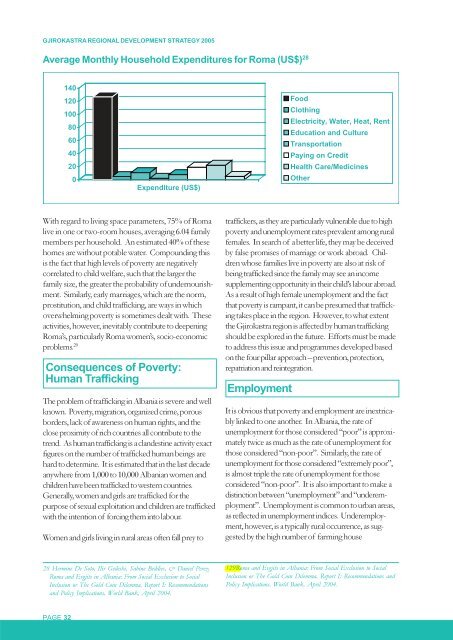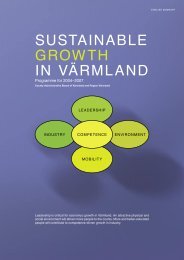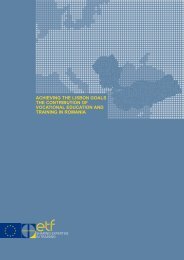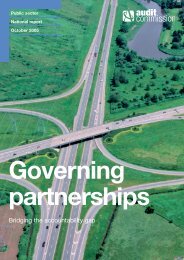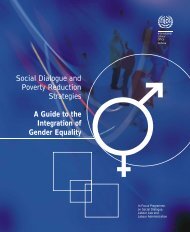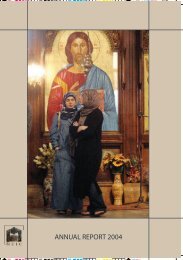PDF (18.5 MB) - Document Database website
PDF (18.5 MB) - Document Database website
PDF (18.5 MB) - Document Database website
You also want an ePaper? Increase the reach of your titles
YUMPU automatically turns print PDFs into web optimized ePapers that Google loves.
GJIROKASTRA REGIONAL DEVELOPMENT STRATEGY 2005<br />
Average Monthly Household Expenditures for Roma (US$) 28<br />
140<br />
120<br />
100<br />
With regard to living space parameters, 75% of Roma<br />
live in one or two-room houses, averaging 6.04 family<br />
members per household. An estimated 40% of these<br />
homes are without potable water. Compounding this<br />
is the fact that high levels of poverty are negatively<br />
correlated to child welfare, such that the larger the<br />
family size, the greater the probability of undernourishment.<br />
Similarly, early marriages, which are the norm,<br />
prostitution, and child trafficking, are ways in which<br />
overwhelming poverty is sometimes dealt with. These<br />
activities, however, inevitably contribute to deepening<br />
Roma’s, particularly Roma women’s, socio-economic<br />
problems. 29<br />
Consequences of Poverty:<br />
Human Trafficking<br />
The problem of trafficking in Albania is severe and well<br />
known. Poverty, migration, organized crime, porous<br />
borders, lack of awareness on human rights, and the<br />
close proximity of rich countries all contribute to the<br />
trend. As human trafficking is a clandestine activity exact<br />
figures on the number of trafficked human beings are<br />
hard to determine. It is estimated that in the last decade<br />
anywhere from 1,000 to 10,000 Albanian women and<br />
children have been trafficked to western countries.<br />
Generally, women and girls are trafficked for the<br />
purpose of sexual exploitation and children are trafficked<br />
with the intention of forcing them into labour.<br />
Women and girls living in rural areas often fall prey to<br />
PAGE 32<br />
80<br />
60<br />
40<br />
20<br />
0<br />
Expenditure (US$)<br />
28 Hermine De Soto, Ilir Gedeshi, Sabine Beddies, & Daniel Perez,<br />
Roma and Evgjits in Albania: From Social Exclusion to Social<br />
Inclusion or The Gold Coin Dilemma, Report I: Recommendations<br />
and Policy Implications, World Bank, April 2004.<br />
traffickers, as they are particularly vulnerable due to high<br />
poverty and unemployment rates prevalent among rural<br />
females. In search of a better life, they may be deceived<br />
by false promises of marriage or work abroad. Children<br />
whose families live in poverty are also at risk of<br />
being trafficked since the family may see an income<br />
supplementing opportunity in their child’s labour abroad.<br />
As a result of high female unemployment and the fact<br />
that poverty is rampant, it can be presumed that trafficking<br />
takes place in the region. However, to what extent<br />
the Gjirokastra region is affected by human trafficking<br />
should be explored in the future. Efforts must be made<br />
to address this issue and programmes developed based<br />
on the four pillar approach – prevention, protection,<br />
repatriation and reintegration.<br />
Employment<br />
Food<br />
Clothing<br />
Electricity, Water, Heat, Rent<br />
Education and Culture<br />
Transportation<br />
Paying on Credit<br />
Health Care/Medicines<br />
Other<br />
It is obvious that poverty and employment are inextricably<br />
linked to one another. In Albania, the rate of<br />
unemployment for those considered “poor” is approximately<br />
twice as much as the rate of unemployment for<br />
those considered “non-poor”. Similarly, the rate of<br />
unemployment for those considered “extremely poor”,<br />
is almost triple the rate of unemployment for those<br />
considered “non-poor”. It is also important to make a<br />
distinction between “unemployment” and “underemployment”.<br />
Unemployment is common to urban areas,<br />
as reflected in unemployment indices. Underemployment,<br />
however, is a typically rural occurrence, as suggested<br />
by the high number of farming house<br />
129Roma and Evgjits in Albania: From Social Exclusion to Social<br />
Inclusion or The Gold Coin Dilemma, Report I: Recommendations and<br />
Policy Implications, World Bank, April 2004.


